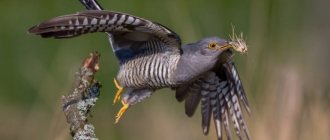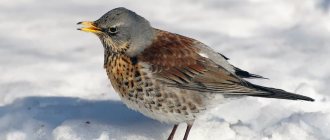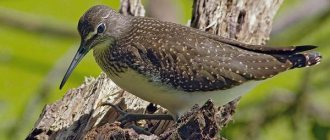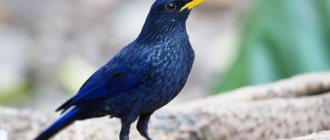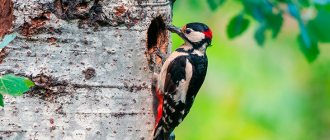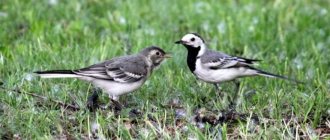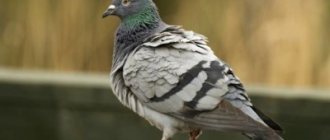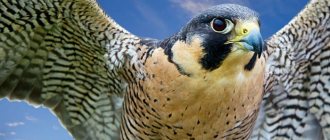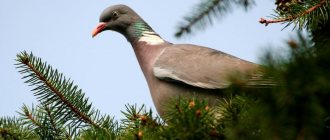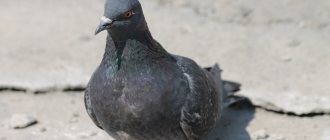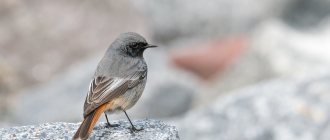574
no comments yet
0
Author:
Kiva Anatoly.
Reading time: 1 minute
- Hello! I became curious: what kind of ordinary pigeons are they - wintering or migratory? It seems that you can find them in cities all year round. From a scientific point of view, where can they be classified?
– It’s not so easy to give a definite answer to your question. In general, it should be considered that almost all currently known species of pigeons are mainly sedentary, that is, wintering birds, making long-distance flights only in exceptional cases .
And in order to understand it completely, first of all, let’s define the terminology.
Features of the life of pigeons in the cold season
Do not think that birds have an easy time withstanding winter, because the air can cool to the most extreme temperatures. But most often birds suffer from hunger and lack of water.
Pigeon in winter
Note! Pigeons that live outdoors often disappear from malnutrition, hypothermia, or indigestion.
While the ground has not yet hardened from severe frosts, pigeons eat grain sown in the field. Only with adequate nutrition will birds survive the winter. During the cold season, their body has to expend significantly more calories than in the warm season.
Birds can fly up to 50 km to find food. In the city it is very difficult to find food for birds; their only place of sustenance is trash cans. You can feed the birds:
- seeds;
- small nuts;
- chopped corn kernels.
Important! Under no circumstances should pigeons be fed bread crumbs, as crumbs are heavy food for the stomach and cause upset. In addition, bread has no energy value for birds.
It is recommended to give pigeons ready-made food intended for an average parrot. They contain all the necessary substances in the correct proportions. You can buy food at any specialized store.
In search of water, pigeons eat ice and snow, which is dangerous for their body. They get hypothermia precisely because of this, since their thick plumage and fluff prevent them from freezing even in severe frosts. If birds eat properly, they can easily survive the winter.
Where do birds spend the winter?
During the day, birds can be found on the streets, in parks, and in courtyards, where they look for food and bask in the sun's rays. Late in the evening they can disappear, and few people know where pigeons go at night in winter.
Pigeons spend the night in the attics of houses
For overnight stay they choose:
- attics of multi-storey buildings;
- buildings housing technical premises;
- roof overhangs;
- architectural decorations of houses.
Woodpecker
In winter, the woodpecker's main food is seeds and nuts, which they obtain from the cones of coniferous plants. Birds create real storerooms and forges by placing pine cones in crevices and crushing them with their beaks. In the forest, after their activities, you can find a lot of such husks. Instead of water in the cold season, they swallow snow.
A distinctive feature of the woodpecker's color is the red cap. Their beak is strong and long. Singing is somewhat similar to screaming. Woodpeckers fly excellently.
Keeping and feeding pigeons in winter
Domestic pigeons are given special conditions of detention, which differ significantly from the life of wild birds in nature. But, despite this, neither domestic nor wild birds are omnivores, and their diet must be treated carefully.
When choosing food for birds in winter, you need to take into account the fact that during this period their body needs a sufficient amount of vitamins and calories. At home, pigeon food should consist of the following products:
- oats;
- corn;
- barley;
- lentils;
- boiled potatoes;
- carrots;
- cabbage;
- apples;
- bananas;
- rapeseed;
- flax;
- sunflower;
- wheat bran;
- crushed lime;
- bone meal.
In addition, a complex of vitamins and minerals is added to the feed.
The pigeon died from hypothermia
Owners of domestic breeds should know what to feed pigeons in winter. This category includes:
- millet;
- peas;
- wheat;
- buckwheat;
- Vika.
Foods that should never be fed to pigeons:
- bread;
- cheese;
- milk;
- sour cream;
- fish;
- meat products;
- citrus fruit;
- sweet pastries;
- salo.
Birds need a lot of water and this becomes a major problem in winter. The plumage serves as reliable protection from the cold, but if grains of ice or snow get into the birds’ intestines, the body experiences severe stress due to hypothermia, which can cause them to die. For this reason, there should always be warm water in the drinking bowls. To do this, install heating or pour liquid in a small amount. The water should be at least +8 degrees.
Important! Under no circumstances should birds be allowed to drink water from melted ice or snow, as it accumulates a large number of bacteria that cause intestinal upset.
How to reduce sexual activity
You can breed pigeons all year round, but most often only professional breeders do this. Beginners should take a break during the winter, as eggs can freeze in low temperatures. In addition, drafts cause considerable damage to masonry.
To reduce the sex drive of birds, it is necessary to exclude protein foods from their diet. The causative agent of pigeon libido is hemp seed, so it should never be given to birds in winter.
Wintering and migratory birds
Some widespread bird species are migratory in some places and sedentary in others. Among wild pigeons there are migratory, nomadic and sedentary birds. The gray crow from the northern regions of the Soviet Union flies to the southern regions for the winter, and in the south this bird is sedentary.
In our country, the blackbird is a migratory bird, but in the cities of Western Europe it is a sedentary bird. Rooks in more northern latitudes are migratory birds, and in more southern latitudes, for example, in Ukraine and the Black Earth Region, they are sedentary. The house sparrow lives in the European part of Russia all year round, and flies from Central Asia to India for the winter.
Do you need a dovecote, or can you keep it outside?
Most breeds of domestic pigeons in the countryside easily tolerate severe frosts, so they can also be kept outside. But for this they need to provide them with the following conditions:
- build a protective canopy from bad weather;
- make sure that the air temperature does not drop below -7 degrees;
- feed birds exclusively with high-calorie food;
- place drinking bowls with heated water;
- have a room where pigeons can hide from predators.
Decorative breeds of birds with unusual coloring are best kept in a special room - a dovecote. You can insulate the birds' homes using mineral wool or polystyrene foam, hiding them behind plywood or chipboard sheets. It is imperative to make sure that there are no cracks at all, which will prevent the occurrence of drafts.
In a house for pigeons, the space should be divided into sections where the nest is installed, and you also need to make a feeder and perches.
A feeder, drinker and bath must be installed in the dovecote
To continue daylight hours for birds, lighting fixtures are installed in the dovecote. To ensure a regular supply of fresh air, ventilation with valves is installed in the room.
Reproduction and raising of offspring
Blues form strong, monogamous families, show great respect for each other and care for their partner. They remain faithful to their spouse throughout their lives. Observation of the behavioral characteristics of pigeons gave rise to a popular expression among people, according to which partners in love are often called doves.
Pair of pigeons
Birds reach sexual maturity at the age of six months. Birds living in warm climates breed throughout the year. Moreover, for pigeons living in the northern regions, the breeding season occurs during the warm season.
Males, noticing a suitable partner, begin to coo, thereby flirting with the dove. In addition to cooing, they demonstrate dance-like movements, fluff their tails and try to “hug” females with their wings. In this case, the choice always remains with the female: if she likes the partner, she shows favor and allows him to perform mating games. If the pigeon is not to his liking, the female may refuse him and wait for a new suitor.
The formed pair begins to build a nest. The male is responsible for obtaining material for its formation. He brings branches, fluff, and the female is engaged in arrangement using the found prey.
Dove chick
After the first mating, egg laying occurs approximately two weeks later. Often the female lays no more than two eggs. The second egg appears a few days after the first. The duration of incubation is about 17-18 days. The partners take turns incubating the eggs and replace each other. Usually the male does this during the day, while the female incubates the offspring at night.
The chicks are not born at the same time, as the eggs were laid at different times. The difference in the appearance of the second chick can be about two days.
In one season, a pair can reproduce at least four broods.
How to help birds in winter
Man, trying to preserve bird populations, tries to help them in the winter season. One of the ways is to equip birdhouses, where birds can hide from blizzards and blizzards. You can buy a birdhouse, or you can make it yourself. You cannot make birdhouses from plastic bottles and bags, as they are transparent and will cause discomfort to the birds. It is also not recommended to make a birdhouse out of plywood, since chemicals are used in its manufacture. Plywood can only be used for exterior decoration of the house. Wood, too, not just any one will do. For example, conifers emit resin, which is harmful to birds. Maple, oak, aspen, alder are the best trees for making. It is better not to treat the inner surface of the birdhouse, as it will be easier for the birds to move around inside.
If you are making several birdhouses, you need to place them at a distance of at least 25 meters from each other. Birds do not like close proximity.
Arranging feeders can also help birds. Feeders can be made from different materials at hand. For example, from plastic bottles. But since they are not durable, they need to be changed every three months. Ideas for making feeders can be very different. Feeders can be hung from branches or mounted on a pole. The most important thing during manufacturing is to provide a hard surface.
Feed the birds in winter project
To draw attention to the problems of wintering birds, social projects are being carried out.
It is necessary to write a work plan:
- Talk about the importance and necessity of helping birds in winter.
- Create a group that will participate in the creative process.
- Create a project plan together.
- Process the collected material.
- Making and placing feeders and birdhouses.
Methods that are used when drawing up a social project:
- observations;
- excursions;
- study of literature;
- collecting information on Internet resources;
- creative work.
Poultry lessons in winter
The purpose of the lesson is to broaden children's horizons in the field of ornithology. Tasks -
- Tell children about wintering birds and the role of humans in the lives of birds.
- Supplement children's knowledge.
- Teach children to help birds.
Recommendations - after classes, you can invite the children to make feeders.
Progress of classes
Someone knocked on the door. The presenter says, “Guys, the postman brought a letter from the old forest man.” Look what he writes: Guys, you know that many birds cannot stand the cold season and strive to fly to where it is warm. But there are also those who remain to spend the winter and they really need your help. What kind of birds are these and what they eat, you will find out by solving the riddles:
Guess what is hiding at the table among the birches, he treats the birds with bread and grain. (feeder)
Tell the children what a feeder is and why it is needed. Is it possible to do it yourself?
Jumps merrily next to me, Small, gray, funny. I’ll sprinkle some crumbs for you to peck, I won’t let the cat catch him , you tweet more cheerfully, my good one (sparrow)
Show the sparrow in the picture, listen to an audio recording of the sparrow chirping. Guys, in winter, you live in houses, you are warm. When you go outside, you put on warm clothes, but how can sparrows survive in the bitter cold? An old forest man sent us a story about a sparrow.
Guess riddles about other birds:
Grayish coloring, Thieving behavior, Hoarse screamer, Known person Her name is (crow).
There is a knock and a whistle. The one who knocks is the telegraph operator. Hello buddy I'm signing (woodpecker)
Apple trees on the branches, Collect them quickly. The apples of the Flock (of bullfinches)
Look on the balcony, Who is cooing until dawn, You will eat this bird, Call him a postman (pigeon)
I suggest you hang a feeding trough in the yard after class. Now, let's count how many birds flew to the feeder. I read a poem, and you bend your fingers.
Who can tell how many birds flocked? (children's answers)
Now, let's make a sparrow from a pine cone. You will need:
- Cone
- Cardboard
- Plasticine
- Branch or wooden sticks
From plasticine, white, we make balls - the whites of the eyes, then from plasticine, black or brown, we make two more circles and place them in the middle of the white ones. Cut out the wings and tail from cardboard. They can be of different sizes, depending on the type of bird. We attach all the details to the cone.
How birds prepare for winter - the world around them
Winter is not an easy time for birds. All the spider bugs are hiding, the ground is covered with snow, and the reservoirs are freezing. With the beginning of autumn, many birds begin to eat intensively in order to accumulate fat for winter. Some species gather in flocks, and in such a group it is easier to find food and stay warm. Birds of prey, having killed their prey, hide it in order to feast on it in winter. There are those who like to nest in severe frosts, these are crossbills, when the cones ripen, there is food for the chicks. In order not to die of hunger, each bird representative prepares in its own way. Many of them settle where people live (cities, villages), for example, tits and bullfinches. Moscow. The woodpecker builds its nest in a hollow, lining it with twigs and grass so that in cold weather it can keep warm. Black grouse and partridge bury themselves in the snowdrifts and warm themselves. The nuthatch makes supplies in the bark of trees, nutcrackers hide nuts in the snow, goldfinches look for food in protruding plants, the jay makes supplies by burying them in the ground. Capercaillie feeds on bark, black grouse and hazel grouse eat alder catkins.
The world around birds in winter
The world of birds in our world is quite large. Among birds there are species that fly to warmer climes, but quite a few birds remain to spend the winter. They adapted to environmental conditions and the changing seasons. The main thing that nature has laid in them is the ability to look for food and make reserves from it. There are specimens that fly very high, and there are those that cannot fly at all. The contribution of birds to the symbiosis of nature is invaluable; in many ways, they help regulate the number of insects, small rodents, and the growth of new plants.
- destroy harmful insects;
- promote plant pollination;
- exterminate small rodents;
- serve as food for other animals;
- spread plant seeds.
The body temperature of birds is 41 degrees. Their migration is not associated with frost, but with the ability to obtain food. Many birds eat insects. With the onset of cold weather, insects become fewer and fewer and birds begin to prepare for migration. From this moment on, the volume of their diet increases. This suggests that they are storing fat for the long flight. But, many, individuals. remain in the forests or fly to human habitation.
Natural enemies of pigeons
Pigeons have quite a lot of enemies in natural conditions. A significant threat to them is posed by other birds of prey, which are not averse to hunting birds. A particular danger comes from hawks, which often become active with the onset of the mating season for pigeons. Also natural enemies are grouse, quail, and falcons, which love to feast on pigeons.
Falcons are capable of specially flying into urban areas and destroying dovecotes built by people.
Also, sick, weak pigeons can be attacked by crows hunting old birds or, on the contrary, still fragile offspring. The danger in urban environments also comes from ordinary cats, which seek to hunt birds that forage for food or rest on the ground.
In the wild, nests can be destroyed by such animals as:
- Foxes.
- Martens.
- Snakes.
- Ferrets.
In addition, the pigeon population is reduced by mass diseases and epidemics. Due to the fact that birds live in flocks, infection quickly spreads among them. Therefore, people often avoid pigeons, considering them carriers of various diseases.
